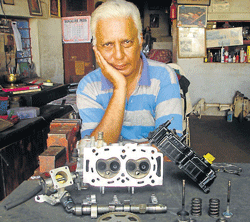
Three years ago, Ravi Kumar, a vehicle enthusiast, met Somender Singh. Ravi had come to know about an unique invention that increased the performance of any engine.
Singh, who had developed the technology to increase the efficiency of engines by at least 10 per cent, offered to install the technology in his car. “It is like driving a new car everyday,” says Ravi. The seemingly miraculous transformation in his old car is due to ‘Grooves’.
“The easiest way to make your old car run better is to check out the prices of a new car”, was a sticker at Garuda Research and Development, or Garuda garage. It is a small garage that often eludes the attention of people who drive past the Chamundi Vihar Indoor Stadium.
Located right opposite the stadium, the place belongs to Somender Singh. An avid enthusiast of engines, his passion for motor vehicles have taken him to many places. But, he was not one of those who would just drive the car around without knowing what made the car move.
Unburnt fuel
After learning about the fine aspects of the engine, he realised that a huge amount of fuel remained unburnt and resulted in toxic emissions. “If we consider a petrol engine, the engine burns 14 litres of air for every litre of petrol and emits gases that are colourless, odorless and are harmful to life-forms on earth. It was necessary to reduce these emissions,” he said.
That thought and his relentless endeavor to contribute towards reducing pollution, for a green planet, led to US Patent 6237579.
The patent was awarded in 2001 to Singh for his ‘Design to Improve Turbulence in Combustion Chambers’.
‘Groove’ design
The design is an ingenious alteration in the normal engine. The Groove technology of Singh can be implemented not only to four wheelers, but also to motor bikes.
The design deformed the regular engine in a constructive manner, by creating grooves in parts of the engine, which resulted in smoother and better performance of the vehicle.
Taking a test drive in his ‘old’ Maruti 800, he can travel at only 20 kilometres per hour, while the top gear is engaged. Surprisingly, the engine does not knock. The grooved engine also consumed a lot of lesser fuel.
“If it takes about 10 litres of petrol to drive from Mysore to Bangalore in the normal engine, with the grooved engine it would require only 9 litres or even eight,” he pointed out.
Several reputed companies have approached him to make use of the technology, but he said with automobile companies “it is always a catch-22 situation.”
However, he questions “What good are discoveries and inventions if they are not put to use?” Well, that is a long-standing question indeed.
